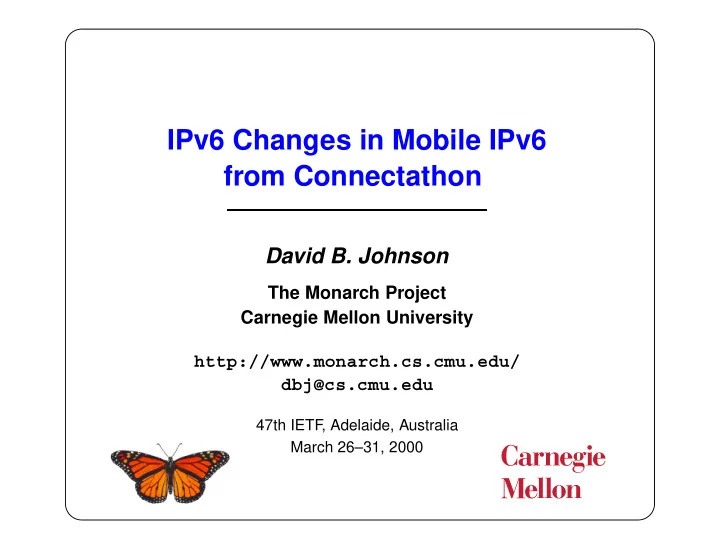

IPv6 Changes in Mobile IPv6 from Connectathon David B. Johnson The Monarch Project Carnegie Mellon University http://www.monarch.cs.cmu.edu/ dbj@cs.cmu.edu 47th IETF, Adelaide, Australia March 26–31, 2000
Overview of Recent Changes I submitted draft-ietf-mobileip-ipv6-10.txt on February 10: � Issues raised at last IETF meeting (Washington, DC) � Some issues raised on mailing list and private email I submitted draft-ietf-mobileip-ipv6-11.txt on March 10: � Issues raised by implementors at Mobile IPv6 interoperability testing at Connectathon 2000 that week � A few more issues raised on mailing list and private email Areas of changes since last IETF meeting : � IPsec processing � Duplicate Address Detection � Movement detection � Dynamic Home Agent Address Discovery � Miscellaneous
Duplicate Address Detection for Home Address While away from home : � Needed, for example, when home subnet renumbers � Added a Duplicate Address Detection (D) bit in the Binding Update � Requests mobile node’s home agent to perform DAD on the mobile node’s home link for the home address in this binding � Home agent performs DAD before returning the Binding Acknowledgement � Returns new Status value of 138 (Duplicate Address Detection failed) in Binding Acknowledgement, if failure � Mobile node knows it needs to wait extra time for the Binding Acknowledgement if it sets the D bit in Binding Update � Mobile node uses same procedures/algorithms for use of DAD as if it were at home
Duplicate Address Detection for Home Address When returning home : � Mobile node needs to send a Binding Update to its home agent � But home agent is defending mobile node’s home address for DAD � Home agent also is set to tunnel home address to care-of address � Mobile node may already know home agent link-layer address, for example from Router Advertisements � If Neighbor Solicitation is needed, must set Solicitation source address to the unspecified address � Alternative is to send Binding Update to MAC address corresponding to solicited-node multicast address for its home agent � Mobile node must not perform DAD on its own home address
Performing DAD for Care-of Addresses IPv6 says perform DAD before assigning a new address : � Defined in RFC 2462 (IPv6 Stateless Address Autoconfiguration) � Used for all addresses, whether stateless or stateful � For stateless, can test only link-local address if all others use the same interface identifier Problem for Mobile IPv6 : � Mobile node would need to perform DAD for each new care-of address, each time it moves! � DAD takes a “long” time: – Mobile node sends DupAddrDetectTransmits (default: 1) Neighbor Solicitations, each separated by RetransTimer (default: 1 second) – If first message to be sent from an interface after interface (re)initialization, should random delay between 0 and MAX RTR SOLICITATION DELAY (1 second)
Can We Avoid This? Is DAD for each address really required? � RFC 2462 is ambiguous and contradictory on this � “Duplicate Address Detection MUST take place on all unicast addresses, regardless of whether they are obtained through stateful, stateless or manual configuration” � “For safety, all addresses must be tested for uniqueness prior to their assignment to an interface” � “Each individual unicast address SHOULD be tested for uniqueness” Can we optimize the use of DAD in any way? � For example, random delay for MAX RTR SOLICITATION DELAY should be safe to skip � Designed to randomize many hosts all booting at the same time � But in a foreign network, we aren’t booting � Also, can we perform DAD in parallel with normal use?
Movement Detection for Mobile Nodes Mobile node’s must be able to detect when they move : � For example, wireless movement out of range of access point � Need to detect this and configure a new care-of address from some new router from which you hear Router Advertisements � Defined mechanism is deliberately flexible, to allow choice by implementors � But an incorrect implementation at Connectathon made us think more about the defined mechanism Planning to define a more specific movement detection mechanism : � Want something that allows quick movement detection � Want something that works with non-mobile-aware local routers � Need to detect new and missed Router Advertisements, plus expiration of Default Router List and Prefix List entries � But its hard to know when you’ve missed a Router Advertisement � Can also supplement with lower layer information on some links
Dynamic Home Agent Address Discovery Originally specified use of anycast Binding Update is awkward : � All Binding Updates must be authenticated � But this one can’t be, since destination is anycast address � And it really is very different than normal Binding Update processing New mechanism defined in version 11 of draft : � Mobile node sends ICMP Home Agent Address Discovery Request to home agent anycast group � Some home agent on home link responds with ICMP Home Agent Address Discovery Reply � Reply contains ordered list of home agents � Removed Home Agents List Sub-Option definition and Binding Acknowledgement option Status value of 135 (dynamic home agent address discovery response) � Still need ICMP type code assignments from IANA (I’ve requested them)
Recommend
More recommend